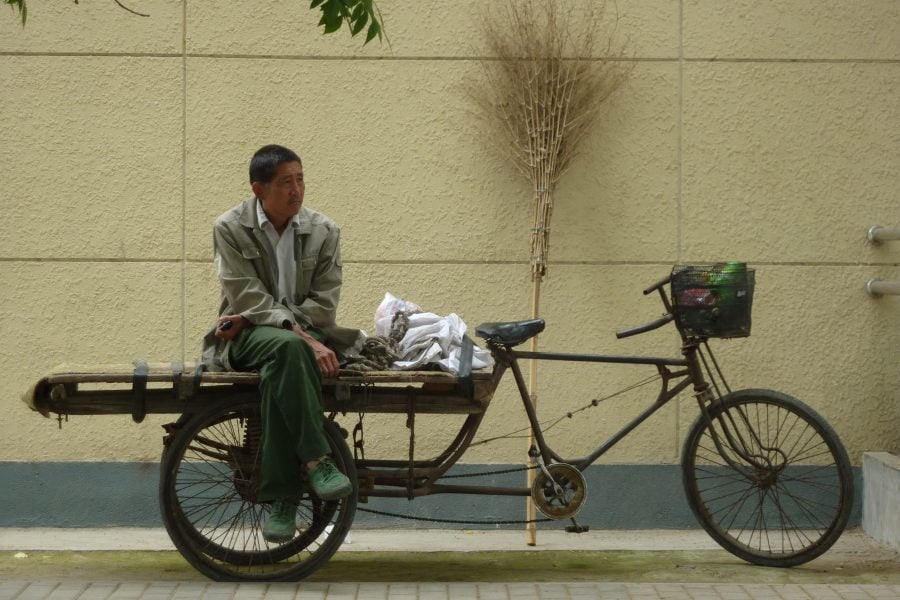Every now and then I hear someone say that what the country (whatever country I happen to be in) needs is a dictatorship to sort out the lefties / rightists / bleeding heart liberals / gun-toting rednecks (add your own preferred enemies). Well, here’s what happens when you really do have a dictatorship – albeit by another name.
It bans motorcycles.

Sorry, Mr Yu; no more moto-rickshaws in Beijing.
China’s domestic motorcycle sales reached the all-time record of 26.9 million sales in 2014. In the following year, the Chinese Government took the dramatic and almost unbelievable decision to ban motorcycles in urban centres, causing the industry to experience the steepest decline ever reported in the motorcycle industry world, at least as far as I know. In 2016, the market fell more than 10 million to end up at 16.8 million.
The government explained that the decision was aimed to cut down urban pollution, imploring people to use public transportation. The justification behind this was that most Chinese motorcycles are two strokes, and these have much higher exhaust emissions than four stroke powered motorcycles.
The initial consequence of banning this more or less traditional mode of transport (mainly consisting of scooters) was a boom for the e-bike (moped or electric bike) industry, leading up to a record of 30 million annual sales. That didn’t go entirely well; the increased use of e-bikes has some pronounced drawbacks in China. A walk through a Chinese city with a high population of e-bikes reveals these problems clearly: electric bicycles zipping around in every direction, dominating the bike lanes, taking over the sidewalks, just about running down pedestrians, and weaving in and out of traffic often with little heed to road rules or personal safety.

曾经在北京有过一家戈德林俱乐部。想知道他们现在在做什么?
As a result, more than a dozen major metropolitan areas, including Beijing, Shanghai, Guangzhou, Xiamen, and Shenzhen, have restricted or outright banned e-bike usage for safety reasons. Simple enforcement of the road rules by police doesn’t seem to have crossed anyone’s mind. China is different.
所以我们有摩托车和踏板车被禁止,因为他们污染了(或他们中的一些人,双程)和E-Bikes被禁止,因为它们不安全。奇怪的是,这两个禁令只袭击了普通人。哈雷 - 戴维森所有者可能不同意,看看自己略高于普通人,但他们还有很多人在人民共和国。

Quis custodiet ipsos custodes? Will someone keep police scooters off the road?
整个过程对我来说似乎很奇怪,所以我在北京的摩托车会议上询问了我的翻译。他很遗憾地看着我。“所有两轮车都妨碍了汽车。这很烦人,“他说。“并且在汽车中被驾驶的恼怒的人是制定规则的人。”
仍然认为独裁统治是个好主意?
Despite all this, the Chinese market is still one of the largest in the world after being overtaken in 2016 by India and now sits in second place with a growing gap behind the leader but still ahead of Indonesia and Vietnam. The market recovered in the 2019 ending the year with 16.4 million units (including two-wheeler and commercial tricycles), up 5% from the previous year. Following years of decline, the traditional combustion segment is growing while the electric scooter segment, the largest in the world, continues to ease.

如果您可以随购物捕获Moto-rickshaw,您会使用公共交通吗?
China currently represents 24.9% of global motorcycle and scooter sales. The momentum of Chinese economic growth remains weak, although the recently signed trade agreement with the US will help growth to recover. Meanwhile, mounting economic uncertainty is postponing investment plans. The Chinese motorcycles market is no longer the locomotive of the global industry after bottoming out in 2018, when the market landed at 15.5 million units, more than 7 million below the global leader, India.
由于美好的岁月,中国的摩托车行业发展了世界上最大的摩托车生产设施。该行业以重庆市为中心的三个地区 - 广东和浙江省省和重庆市。在他们之间,它们的生产能力是惊人的。随着最近印度摩托车销售的下降,毫无疑问,它可以恢复最大的摩托车行业冠军 - 如果只有独裁者就会让它......







